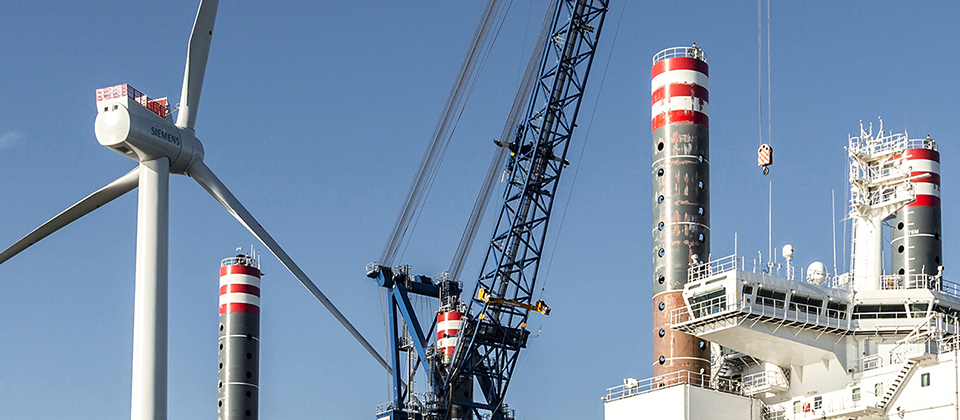
Announcing a new, larger turbine is comparatively easy. Bringing it to market, however, may take as many as eight years to achieve. For 2014, expect to see a rush of new machines variously being hinted at, announced, tested or put into production.
Over the past year or so, it seems as if all the major turbine manufacturers – including one or two who are new to the offshore side of the business – have stepped up the pace of developing new, larger turbines. In fact, the battle to design the world’s longest blades has seen an increase of around 10 metres in just 18 months.
Why all the activity? Because giant turbines are key to reducing the cost of energy, with plenty of engineering evidence supporting the widespread belief in more environmentally friendly electricity from larger generators.
And it’s not all about costs – for example, larger turbines rotate more slowly, too, causing less of a distraction for the human eye. Of course, such large structures don’t come without significant challenges from an installation point of view (see, for example, Single-blade Installation to the Rescue on page 18).
But nothing’s impossible, at least for now, so it’s most likely onwards and upwards from the already impressive list we present here.
Samsung Heavy Industries S7.0-171 MW
The Big Daddy of them all right now is Samsung’s 7 MW offshore turbine. Its blades stretch some 83.5 metres in length, and it is also the world’s most powerful operating turbine.
The first prototype, taller than London’s BT Tower at 196m, was completed in October last year and began a multi-year testing programme at Scotland’s Fife Energy Park. Certification will be completed by the end of 2014.
Siemens SWT-6.0-154
Also called Turbina Sapiens (roughly: “intelligent turbine”), prior to October 2013 the SWT-6.0-154 could claim the world’s largest blades at 75-metres long (rotor length 154). Prototypes for the direct drive 6 MW offshore machine have most recently been tested at Gunfleet Sands during 2013.
Sales are looking good, with turbines ordered for the UK and German markets by DONG Energy and Statoil. Scheduled for commercial release in 2014.
Vestas V164-8.0 MW
Originally announced as a 7 MW machine, the V164 features 80m blades and a hub height of approximately 105m when deployed at sea. Onshore prototype testing began in late January at Denmark’s national test center at Østerild.
Vestas will initially deliver the new turbine for the extension of DONG Energy’s Burbo Bank wind farm, with serial production possibly commencing in 2015.
Alstom Haliade 150-6 MW
The direct drive, 73.5m-blade Haliade 150-6 MW is currently being tested in France. A second turbine was installed offshore for the first time in November 2013, 40 km off Ostend harbour coast, at the Belwind site in Belgium.
Following the certification of its power curve plans in May 2013, the Haliade will be finally certified during 2014, and pre-series production will begin in 2015.
Areva’s M5000-based 8 MW
France’s Areva has launched an 8 MW turbine based on the company’s commercially deployed M5000, apparently featuring a 180-metre rotor and a medium-speed hybrid gearbox. The prototype will be installed in 2015 at Le Havre, northern France, and serial production is expected for 2018.
Gamesa G-128 and beyond
For now, Gamesa’s largest announced offshore turbine is its nearshore, low-weight 5 MW with a 128-metre rotor, currently being tested in Gran Canaria. The company also expects to be marketing the Areva M5000 under recently announced joint venture plans with Areva, although nothing is set in stone. Currently on the Gamesa drawing board, however, are larger models for the future, including an 8 MW offshore-only turbine.
Mitsubishi 7 MW SeaAngel
The fate of Mitsubishi’s 7 MW SeaAngel turbine, in development since 2011, depends on the company’s joint venture with Vestas, which will see the V164 become Mitsubishi’s preferred large turbine.
The SeaAngel’s blades, longer than those of the V164, may not make the cut, although it appears that the digital hydraulic drivetrain (DDT) system developed by Mitsubishi in Scotland will likely be made available.
Senvion 6.2M152
From the wind energy solutions provider formerly known as REpower comes an advanced, 6.15 MW version of the company’s operationally proven 6.2M126 with a larger rotor diameter (152m) and up to 20 percent higher energy yield at windspeeds of 9.5 m/s.
A prototype of the Senvion 6.2M152 will be installed toward the end of this year near the coast of northern Germany.
Like this post? Subscribe now and get notified about new content!
